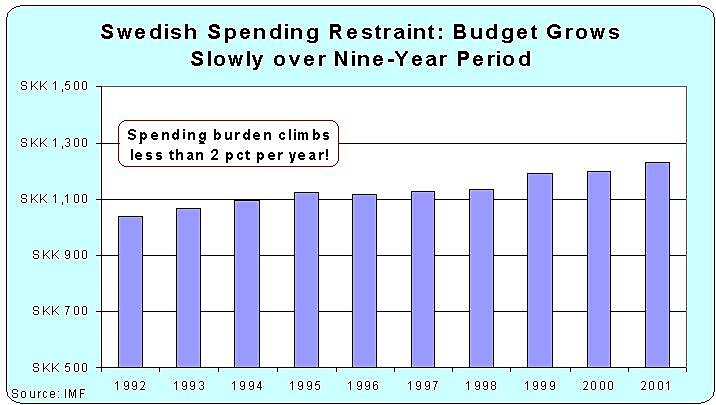When I first started working on fiscal policy in the 1980s, I never thought I would consider Sweden any sort of role model.
It was the quintessential cradle-to-grave welfare state, much loved on the left as an example for America to follow.
But Sweden suffered a severe economic shock in the early 1990s and policy makers were forced to rethink big government.
They’ve since implemented some positive reforms in the area of fiscal policy, along with other changes to liberalize the economy.
I’m particularly impressed that Swedish leaders imposed some genuine fiscal restraint.
Here’s a chart, based on IMF data, showing that the country enjoyed a nine-year period where the burden of government spending grew by an average of 1.9 percent per year.
From a libertarian perspective, that’s obviously not very impressive, particularly since the public sector was consuming about two-thirds of economic output at the start of the period.
But by the standards of European politicians, 1.9 percent annual growth was relatively frugal.
And since Mitchell’s Golden Rule merely requires that government grow slower than the private sector, Sweden did make progress.
Real progress. It turns out that a little bit of spending discipline can pay big dividends if it can be sustained for a few years.
This second chart shows that the overall burden of the public sector (left axis) fell dramatically, dropping from more than 67 percent of GDP to 52 percent of economic output.
By the way, the biggest amount of progress occurred between 1994 and 1998, when spending grew by just 0.27 percent per year. That’s almost as good as what Germany achieved over a four-year period last decade.
It’s also worth noting that Sweden hasn’t fallen off the wagon. Spending has been growing a bit faster in recent years, but not as fast as overall economic output. So the burden of spending is now down to about 48 percent of GDP.
And for those who mistakenly focus on the symptom of red ink rather than the underlying disease of too much spending, you’ll be happy to know that spending discipline in the 1990s turned a big budget deficit (right axis) into a budget surplus.
Now let’s get the other side of the story. While Sweden has moved in the right direction, it’s still far from a libertarian paradise. The government still consumes nearly half of the country’s economic output and tax rates on entrepreneurs and investors max out at more than 50 percent.
But here are the two most compelling pieces of evidence about unresolved flaws in the Swedish system.
First, the system is so geared toward “equality” that a cook at one Swedish school was told to reduce the quality of the food she prepared because other schools had less capable cooks.
Second, if you’re still undecided about whether Sweden’s large-size welfare state is preferable to America’s medium-size welfare state, just keep in mind that Americans of Swedish descent earn 53 percent more than native Swedes.
In other words, Sweden might be a role model on the direction of change, but not on the level of government.



